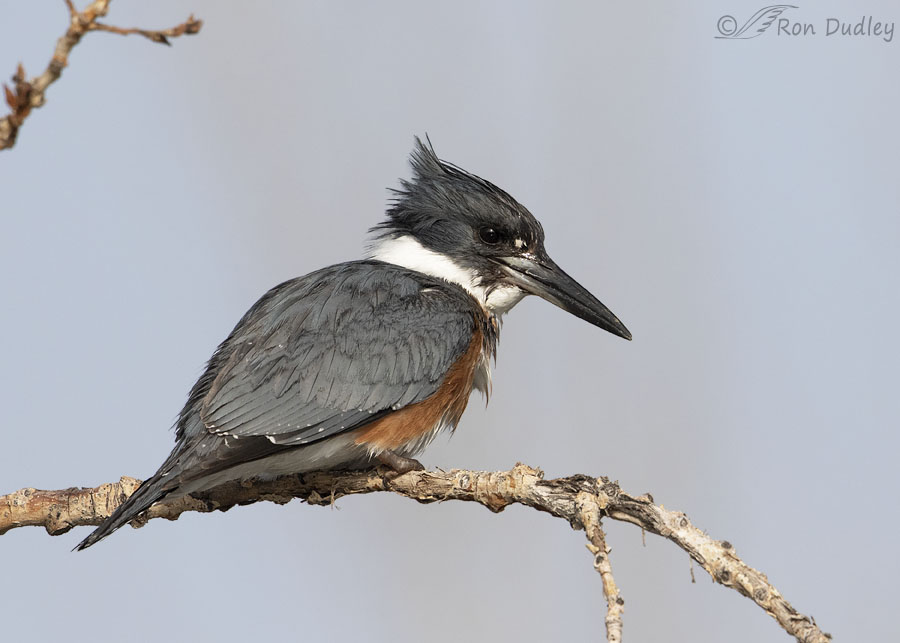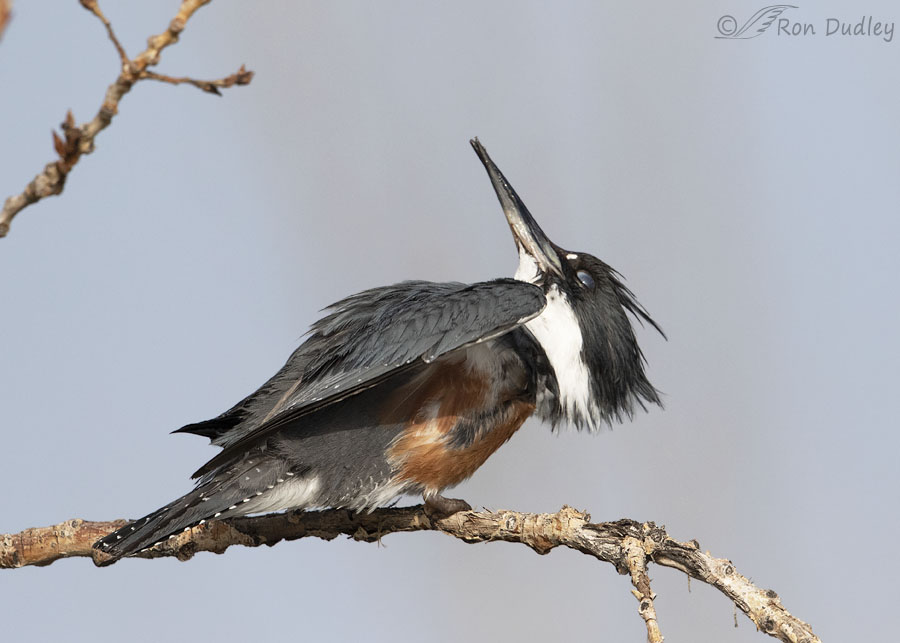A subtle variation in head-shaking style between species that most bird lovers have probably noticed but I suspect few have given any thought to.

1/4000, f/7.1, ISO 800, Canon 7D Mark II, Canon EF 500mm f/4L IS II USM + EF 1.4 III Extender, not baited, set up or called in
This female Belted Kingfisher had just gobbled down a fish (so quickly I have no photos of it) and cleaned her bill on the branch she’s perched on. As they often do in this situation her next move was to vigorously shake her head to rid her bill of any fish debris that might still be clinging to it.
When most smaller birds with smaller, lighter bills (songbirds for example) shake their heads to get rid of clinging debris and/or water the shaking maneuver is extremely fast because their bills are short and don’t weigh much so the circular arc the tips of their bills move through is very short – only a few degrees.
But it’s different with many larger birds, especially those with long and massive (heavy) bills like kingfishers.

1/4000, f/7.1, ISO 800, Canon 7D Mark II, Canon EF 500mm f/4L IS II USM + EF 1.4 III Extender, not baited, set up or called in
When they shake their heads the inertia of their heavy and quickly-moving bills makes it much more difficult for them to change direction quickly. So each cycle of the shake continues for many more degrees of the shaking circle.
When this kingfisher shook her head the shaking circle continued almost 180° in each direction which is why her head is upside down here. At first glance it may look like she’s simply looking above and behind her but it’s just that I had enough shutter speed to freeze her motion in this position so there’s no motion blur. Besides, she’s closed her nictitating membrane to protect her eye during the violent maneuver.
I know, sometimes I focus on trivia and I certainly have here. But when it comes to birds (and to bird photography), trivia matters.
Ron
PS – Holy hell, I really slept in this morning! Usually I’m up sometime between 3 and 4 a.m. so I have plenty of time to write my blog text but this morning I slept in until 5. I never sleep that late! So this is a rush job and it may show. I’ll try to clean it up after I publish the post…


A great catch…
Lovely photos as usual. I have not worked with a king fisher, it would be interesting to see their range of vision around the beak. It seems like it would be like herons, bitterns and egrets where the eye rotates and they look under the beak.
It also reminds me of when bicycle helmets first cam out and they were a heavy plastic and foam. Mine was a heavy Bell helmet. I gave myself whiplash the first time I wore it and turned my head to the left to look for traffic before making a turn. The additional weight really whipped my head around!
That bicycle helmet analogy is a good one, April.
Interesting note and love the two photos. I never cease to be amazed by the size of their beaks! I like the nice display of her feathers in the first. For some strange reason (???) I save my photos of birds with their nictitating membrane in full display in a folder…I think that bit of nature’s handiwork is fascinating. Sleeping in is a luxury to be enjoyed when one does not do it often.
Kathy, I’m becoming much more tolerant of closed membranes in my photos, especially when they involve behavior. I think they’re a fascinating bit of anatomy and evolution.
I suspect you needed the sleep in.
Like you I am usually up early. It is just after 4.30 now and I would have been here earlier if the ‘puter had been playing nicely.
I really like your ‘trivia’ it makes me think about things which may otherwise have passed me by (that said my family talked about small things for small minds).
I look at the other way compared to your family, EC. Seems to me that small minds don’t even notice, much less comprehend, the little things that often have meaning way beyond their proportional size.
Thank you. I merely stick my adult tongue out at them and wander away – still fascinated with minutae.
“I merely stick my adult tongue out”
I can almost visualize that!
Beautiful Kingfisher. One of the most difficult birds to get good photos of. We got the snow last night and continuing this morning. Very wet and heavy. Hope all your Feathered followers had an enjoyable Thanksgiving.
Thank you, Everett.
Fascinating observation. Wonderful that you can and do use your camera for behaviors that would otherwise happen too fast or seem insignificant. Another aspect of bird watching that I will make a point of observing now. Thank you.
That’s one of the primary reasons I so enjoy bird photography, Lyle. It allows me to see and even study things that I wouldn’t even notice with the naked eye.
Don’t forget that cliche, “the devil’s in the details!” As with other cliches, there’s a foundation of truth. Just because the majority of humanity might view minutia as trivial does NOT mean that it IS trivial! Unlike humans. critters rarely waste energy for unnecessary motion and only a few humans contemplate the trivia to discover the reality! You’re one of those humans and I thank you for that. Pondering the trivia (with critters and nature in general) is one of my favorite activities Oh, and as we know, the majority of humanity is just stupid. LOL!!
Oh, and as we know, the majority of humanity is just stupid. LOL!!
I never forget that cliché, Laura. It’s the little things that slip you up (and some folks delight in calling you out for…)
The first thing I thought was, “Oh, her poor neck!” because, yes, my mind immediately went to biomechanics. (Occupational hazard of the kinesiology major. )
)
Second, was to wonder if this is a shot of “your” female with whom you spent many fabulously-documented moments a few years ago.
Glad you were able to get some needed rest. And by the by, this looks like a pretty polished post to me!
““Oh, her poor neck!” ”
Marty, that’s one of the reasons birds have more neck vertebrae than we do (11-26 in birds, 7 for us).
Yes, this is probably that same female.
If it looks polished now that’s because I cleaned it up a little before you saw it! One of the advantages I have over those who comment is that I can edit both my blog text and my comments when I find errors or awkward wording…
Never thought about such things! As usual you provide for “continuing education” – I love it! -3 this morning…..BRRRR! Gotta sleep in once in awhile.
-3 this morning…..BRRRR! Gotta sleep in once in awhile.  Brought up Del Bonita crossing on the net – nice, flat ground that would drift “nicely”
Brought up Del Bonita crossing on the net – nice, flat ground that would drift “nicely” 
“Never thought about such things!”
Judy, I figured that might be the case with many of my readers. I like to think about such things.
The Del Bonita crossing is only about 25 miles north of our farm and I have many relatives in Alberta (my mother was Canadian). Back in the day we used to cross that border without much more than a nod as we passed through. Very different today. The last time I crossed it the American border agent was such an ASSHOLE I haven’t been back to Canada since.
In contrast the Canadian border agents have always, without exception, been unusually pleasant, efficient and professional.
A cousin of mine grew up in Walsh on the Canada side – family had a store and came “state side” frequently. She’s VERY familiar with that crossing and can’t imagine driving school bus there….. She’s been in ID most of her adult life and is about 10 yrs older than we are….. Assholes everywhere don’t need them there!
She’s been in ID most of her adult life and is about 10 yrs older than we are….. Assholes everywhere don’t need them there!
My mother used to worry herself sick when dad would drive that school bus route during and right after blizzards. The drifting snow can be horrendous and often you’re not even sure where the road is with steep “barrow pits” on either side. But dad was an excellent driver and very cautious so he never had a serious incident, though it wasn’t unusual for him to make his “kid delivery” late for school.
I learn something new from you all the time! Thanks. I hope you had a nice holiday.
“I learn something new from you all the time”
That’s something I’m always happy to hear. Thank you, Joanne.
Awesome. Thanks for reminding us of Newton’s first law of motion. I’m curios if you used a hide to get this close to Kingfishers. In my experience, I can’t get closer than 200 feet from them.
Elmer, I considered making this post more physics oriented (inertia, laws of motion, centrifugal/centipedal force etc) but decided to keep it simple, in part because I slept in.
I was using a blind of sorts, a mobile blind (my pickup). I’m nearly always shooting from my pickup.